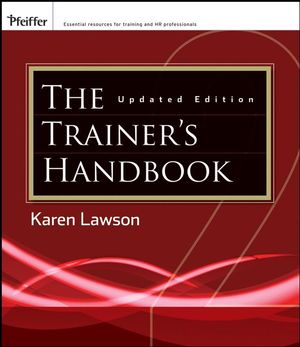The Trainer's Handbook, Updated EditionISBN: 978-0-470-40304-4
Paperback
360 pages
September 2015, Pfeiffer
 This title is out-of-print and not currently available for purchase from this site.
|
Contents of theWebsite.
Acknowledgments.
Introduction.
1. Assessing Needs.
Learning Outcomes.
Understanding the Needs Assessment Process.
Needs-Assessment Process.
How to Conduct a Needs Assessment.
Developing an Action Plan.
Assessing Participants’ Knowledge, Attitudes, Skills.
Key Points.
2. UnderstandingAdult Learners.
Learning Outcomes.
AndragogicalVersus Pedagogical Model.
Understanding How andWhy People Learn.
Learning Styles.
Application of Learning Principles.
Key Points.
3. Training Styles.
Learning Outcomes.
Trainer Characteristics and Competencies.
Training Style.
Increasing Effectiveness.
Learner-CenteredVersus Information-Centered.
Key Elements of a Trainer’s Style.
Key Points.
4. UnderstandingToday’s Learner.
Learning Outcomes.
The Changing Training Environment.
Self-Awareness.
Diversity Issues.
Key Points.
5. Writing Instructional Objectives.
Learning Outcomes.
What Are Learning Objectives?
Writing Learning Objectives.
Key Points.
6.Writing an Instructional Plan.
Learning Outcomes.
Design Philosophy.
Time Needed to Develop a Training Program.
Cost Considerations.
Major Components of Design.
Creating a Design Matrix.
Purpose of an Instructional Plan.
Components of an Instructional Plan.
Instructional Methods.
Developing Materials.
Key Points.
7. Selecting,Designing, and DevelopingActive-Training Methods.
Learning Outcomes.
The Case for Active Training.
Cooperative Learning.
Creating an Active-Learning Environment.
Designing Active-Training Activities.
Common Methods and Materials.
Experiential Learning Activities.
Action Learning.
Key Points.
8. DeliveringTraining.
Learning Outcomes.
Creating a Positive Learning Environment.
Experiential and Active-Training Techniques.
Tips for Using Specific Methods.
Improving Platform Presence.
Key Points.
9. UsingVisualAids.
Learning Outcomes.
Retention Rate inVisual Learning.
Why UseVisual Aids?
Guidelines for UsingVisual Aids.
Other Commonly UsedVisual Aids.
Key Points.
10. Distance Learning.
Learning Outcomes.
Workplace Trends.
Advantages/Benefits of Distance Learning.
Disadvantages/Drawbacks to Distance Learning.
Types of Distance Learning.
Guidelines for Designing Distance Learning.
Designing and Developing Activities.
Delivering Content and Activities.
Blended Learning.
Key Points.
11.Working with Groups.
Learning Outcomes.
The Trainer as Facilitator.
Ways to Encourage Participation.
The Art of Questioning.
Responding to Questions.
Scaling theWall of Resistance.
Problem Situations.
Key Points.
12. Using Creativity.
Learning Outcomes.
Creativity with Small Groups.
Props and Other Theatrical Techniques.
Games.
Creative Closings.
Key Points.
13. EvaluatingTraining.
Learning Outcomes.
Why Evaluate?
When to Evaluate.
Whom to Involve.
How to Evaluate.
What to Evaluate.
Four-Level Model for Evaluation.
Participant Evaluation and Accountability for e-Learning.
Accountability for Training.
Significance of the Evaluation Process.
Key Points.
14. The Business of Consulting: Internal and External.
Learning Outcomes.
The Changing Role of the Trainer.
Understanding the Client-Consultant Relationship.
Selecting an External Consultant.
Follow-Up Reports.
Key Points.
15. Training DuringToughTimes.
Prove theValue of Training.
Peer Teaching.
Leaders as Teachers.
Negotiate with External Consultants and Service Providers.
Supplier/Vendor-Sponsored Training.
Modified Modules.
Lunch and Learn.
Podcasting.
Teleconferences,Teleseminars, andWeb-Casts.
Just-in-Time Materials.
Key Points.
AppendixA: Answers to Exercises.
Appendix B: Recommended Resources.
Appendix C:Criteria for Selecting Packaged Programs.
References.
Index.
About theAuthor.



